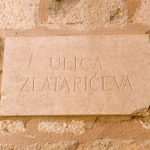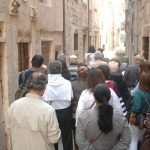In the Old Town, opposite St Francis’ Church, there is a street bearing the name of the Renaissance poet and translator Dominko (Dominic) Zlataric. That street that runs from the main street to St. Rocco’s Church is important for the city and the Republic of Dubrovnik in general. Make a little detour off the main street, it’s well worth your while.
There you’ll find graffiti carved in the year 1597 on the eastern wall of St Rocco’s Church, threatening young footballers of the time in Latin: PAX. VOBIS. MEMENTO MORI QVI. LVDETIS PILA. This translates as ‘Peace to you, remember that you will die, you who play the ball’. Evoking the introduction of Baroque and giving thought to mortality, one can dwell on some unexpected thoughts in front of the wall and the inscription.
Another Latin inscription above the door of a modest house at the beginning of the street can be found. That inscription reads: COCHALVIT . COR . MEV . ITRA . ME . ET . DITATOE . MEA . EXARDESCET . IGNI . ‘My heart became hot within me. As I mused, the fire burned’. Psalm 39 from the Book of David guards the doors to the house where the first Orphanage was founded in 1432. Ospitalle della misericordia, as it was called in Dubrovnik at the time, provided shelter for many unwanted children.
Many girls and women approached the doors at dusk or dawn trying to hide themselves from view, bringing the small bundle and leaving it on the wheel in the window that the nuns would turn and take the child in to their care. At the Orphanage children remained until the age of six and after that they were either taken into foster families or into labour arrangements. Boys were often sent to merchant ships, and girls were taken into houses as maids. Rarely, the mother herself would take the child back and, in order to facilitate later identification, they used to leave half a coin with the child, keeping the other half for themselves.








